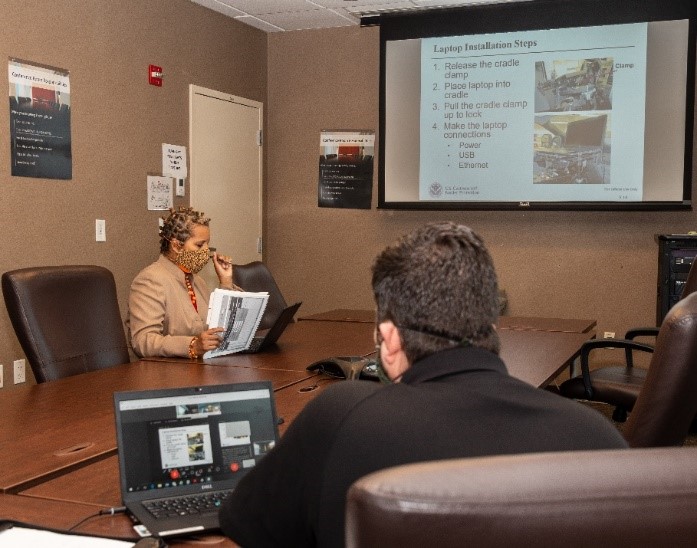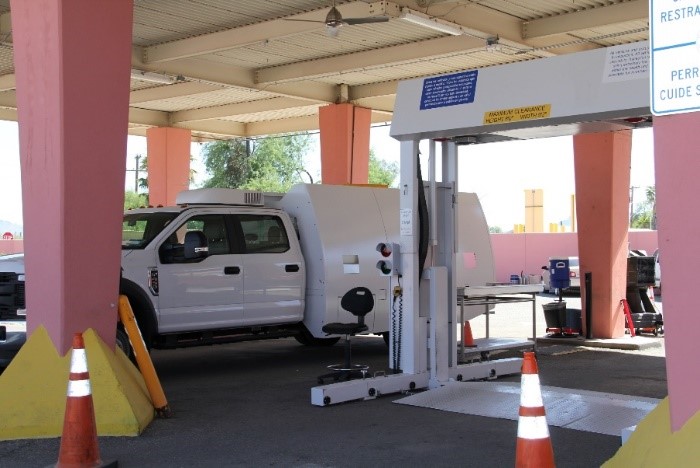Mission success during a global pandemic requires adaptation and creativity.
Not only must U.S. Customs and Border Protection leadership evaluate how to keep frontline personnel safe and able to conduct essential operations, but they must also ensure the workforce is trained and certified to safely accomplish the mission with the tools and resources available.

Agent Guillermo Jimenez and Support
Contractor Angela White of the Non-Intrusive
Inspection Division’s Training Logistics and
Support Branch, conduct a virtual mobile
X-ray unit training using the new
decentralized,video-based model.
CBP photo
When COVID-19 began affecting official travel and in-person group instruction, it showed potential to slow the deployment of critical equipment in the field. The CBP Non-Intrusive Inspection Division’s Training Logistics and Support Branch, with Office of Training and Development support, was already well on its way to adopting flexible measures to quickly revamp and adapt to the new safety protocols.
“The TLSB training plan has evolved during COVID-19,” said U.S. Border Patrol NIID-TLSB program manager, Supervisory Border Patrol Agent Guillermo Jimenez. “With the new norm of social distancing and adhering to a CBP travel ban, things have become increasingly difficult; however, the TLSB has pushed forward exhausting an ‘adapt & overcome’ mentality that has kept us focused on getting needed training out to the field.”
Throughout the COVID-19 crisis, the decentralized training model has maximized existing resources, netting the agency a substantial cost savings by providing virtual training courses to the officers in the field who need it most.
The former in-residence course could train a maximum of 12 students periodically, or once enough students were enrolled to dispatch a trainer to the work unit, said TLSB Branch Chief Eric Demarest. Contrast that to the present virtual training model, some courses now require only two students per course to begin instruction.
Just as training shifted to a virtual platform, three ports of entry in Arizona, California and Texas received new mobile scanners that required both classroom and hands-on training for CBP officers assigned to use the equipment.
“That equipment got delivered right before the lockdown due to the COVID crisis,” said Demarest. “We did have Field Training Cadre (FTC) in place that were certified to deliver that training, so even though everyone was on travel restrictions, those two or three FTCs in that field office were able to train the required staff.”
The mobile vehicle and passenger scanner is both new to the field and to CBP.

deployed to three different CBP ports of entry,
has been instrumental in drug seizures thanks
to the new decentralized training model that
certified CBP officers to use the equipment
despite heightened COVID-19 travel restrictions
and social distancing protocols.
CBP photo
Jimenez shared, “As a supervisor in the field, I have seen firsthand the impact that all NII equipment makes when used correctly. The fact that we can keep our officers and agents safe by giving them a preview of possible threats they may encounter, by using the NII equipment they were trained on, is very satisfying.”
In fact, CBP officers completed their final day of training by locating and seizing a narcotics load with the help of the scanner, a canine team and other officers. Since the mobile scanner’s implementation in February, nearly 220 pounds of methamphetamine have been seized.
“It demonstrates both the efficacy of the equipment and its ability to get the job done from an imaging standpoint,” Demarest said. “Additionally, it proves that the training model that we are rolling out, as well as adapting to deliver it during the crisis, is effective because people that had been involved in the training were now just days later getting large narcotics loads.”
The system's low X-ray output allows drivers and passengers to remain in the vehicle during scanning—unlike a fixed inspection system, which scans vehicles and passengers separately.
One officer, credited with three narcotics seizures using the mobile scanner, acknowledged that because passengers are able to remain in the vehicle during the scanning process, it creates a more at-ease and comfortable experience for travelers, said CBP Officer Cory Nelson who is assigned to the Lukeville Port of Entry in Arizona.
“This particular system allows the car to drive through it and gives the operator a top-down image only, but that image provides a very good overview of the vehicle and the areas that officers otherwise don’t have time to really look at during processing,” said Garret Reinhart, NIID branch chief.
“The image produced by the scanner is immediate and, with training and a little practice, the operator will be able to recognize what is normal within the image and what is abnormal quickly,” Nelson said. “A well rounded team can easily scan, analyze and make the decision to release or refer the vehicle in just a minute or two.”
Next on the team’s agenda is to work with Border Patrol leaders to transition courses to the TLSB model, and to continue adding training courses to the decentralized, virtual platform.

